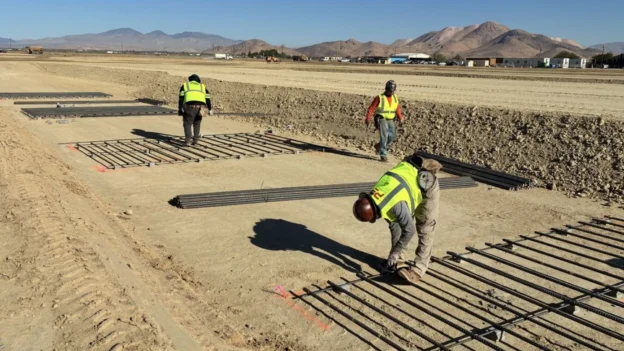Pacific Steel Group is building the first renewable steel plant in the United States, powered almost exclusively by solar and wind energy, in the middle of the Mojave Desert. This facility marks a paradigm shift for the steel industry. steel industry, with a modelThe facility is a paradigm shift for the steel industry, with a model that combines local production, renewable energy and metal recycling to minimize carbon emissions as much as possible.
The production of the renewable iron and steel plant
The plant will occupy some 70 hectares in a region with high solar radiation and constant winds. Solar panels, wind turbines and batteries will be deployed to power electric arc furnaces with the capacity to melt up to 450,000 tons of scrap metal per year.
According to the project’s technical data, this infrastructure will prevent the emission of approximately 370,000 tons of CO₂ per year, the equivalent of removing about 75,000 vehicles from the roads.
The use of clean energy completely replaces the consumption of natural gas and coal, which are common in steel production. In addition, the plant will be equipped with carbon capture systems and advanced and advanced pollutant controls, such as dust collectors, nitrogen oxide control and heat recovery units.
The investment exceeds 540 million euros and includes the support of the State of California, which has granted 30 million euros in tax credits. The project will generate more than 400 direct jobs and has been designed in collaboration with educational centers to train specialized technicians in clean production processes.
Its location will also make it possible to recycle locally a large part of the nearly 500,000 tons of scrap metal that California exports annually. By melting this material at source, emissions associated with transportation are eliminated and logistics costs are reduced.
The Mojave Micro Mill represents a working prototype of what could be the transition to a decarbonized heavy industry. Its approach is also based on the integration of onsite renewable energy, waste valorization and reduction of fossil inputs.
This model can be replicated in other energy-intensive sectors, such as cement or the chemical industry. Moreover, by encouraging production close to the point of consumption, it contributes to reducing urban emissions and promoting regional energy autonomy.
The Mojave case shows that the modernization of industrial infrastructure, far from being a utopia, can become a concrete tool to move towards a circular, low-carbon economy that generates green jobs.
Source and photo: PSG

